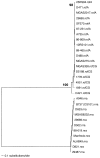Evolution of transcription regulatory genes is linked to niche specialization in the bacterial pathogen Streptococcus pyogenes
- PMID: 15937178
- PMCID: PMC1151717
- DOI: 10.1128/JB.187.12.4163-4172.2005
Evolution of transcription regulatory genes is linked to niche specialization in the bacterial pathogen Streptococcus pyogenes
Abstract
Streptococcus pyogenes is a highly prevalent bacterial pathogen, most often giving rise to superficial infections at the throat or skin of its human host. Three genotype-defined subpopulations of strains exhibiting strong tropisms for either the throat or skin (specialists) or having no obvious tissue site preference (generalists) are recognized. Since the microenvironments at the throat and skin are distinct, the signal transduction pathways leading to the control of gene expression may also differ for throat versus skin strains of S. pyogenes. Two loci (mga and rofA/nra) encoding global regulators of virulence gene expression are positioned 300 kb apart on the genome; each contains alleles forming two major sequence clusters of approximately 25 to 30% divergence that are under balancing selection. Strong linkage disequilibrium is observed between sequence clusters of the transcription regulatory loci and the subpopulations of throat and skin specialists, against a background of high recombination rates among housekeeping genes. A taxonomically distinct commensal species (Streptococcus dysgalactiae subspecies equisimilus) shares highly homologous rof alleles. The findings provide strong support for a mechanism underlying niche specialization that involves orthologous replacement of regulatory genes following interspecies horizontal transfer, although the directionality of gene exchange remains unknown.
Figures


References
-
- Alberti, S., C. D. Ashbaugh, and M. R. Wessels. 1998. Structure of the has operon promoter and regulation of hyaluronic acid capsule expression in group A Streptococcus. Mol. Microbiol. 28:343-353. - PubMed
-
- Anthony, B. F., E. L. Kaplan, L. W. Wannamaker, and S. S. Chapman. 1976. The dynamics of streptococcal infections in a defined population of children: serotypes associated with skin and respiratory infections. Am. J. Epidemiol. 104:652-666. - PubMed
-
- Banks, D. J. 2004. Progress toward characterization of the group A Streptococcus metagenome: complete genome sequence of a macrolide-resistant serotype M6 strain. J. Infect. Dis. 190:727-738. - PubMed
-
- Beall, B. 2004. http://www.cdc.gov/ncidod/biotech/strep/emmtypes.htm.
-
- Beres, S. B., G. L. Sylva, K. D. Barbian, B. Lei, J. S. Hoff, N. D. Mammarella, M. Y. Liu, J. C. Smoot, S. F. Porcella, L. D. Parkins, D. S. Campbell, T. M. Smith, J. K. McCormick, D. Y. Leung, P. M. Schlievert, and J. M. Musser. 2002. Genome sequence of a serotype M3 strain of group A Streptococcus: phage-encoded toxins, the high-virulence phenotype, and clone emergence. Proc. Natl. Acad. Sci. USA 99:10078-10083. - PMC - PubMed
Publication types
MeSH terms
Substances
Associated data
- Actions
- Actions
- Actions
- Actions
- Actions
- Actions
- Actions
- Actions
- Actions
- Actions
- Actions
- Actions
- Actions
- Actions
- Actions
- Actions
- Actions
- Actions
- Actions
- Actions
- Actions
- Actions
- Actions
- Actions
- Actions
- Actions
- Actions
- Actions
- Actions
- Actions
- Actions
- Actions
- Actions
- Actions
- Actions
- Actions
- Actions
- Actions
Grants and funding
LinkOut - more resources
Full Text Sources

